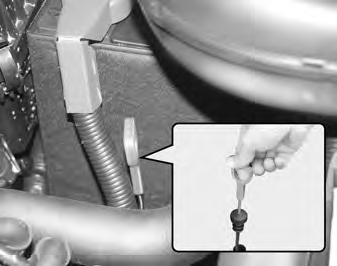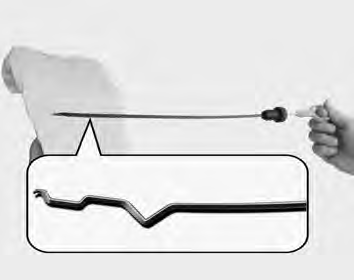 Kia Sportage: Automatic transaxle
Kia Sportage: Automatic transaxle

Checking the automatic transaxle fluid level The automatic transaxle fluid level should be checked regularly. Keep the vehicle on the level ground with the parking brake applied and check the fluid level according to the following procedure. 1. Place the selector lever in N (Neutral) position and confirm the engine is running at normal idle speed. 2. After the transaxle is warmed up sufficiently (fluid temperature 70~80 °C (158~176 °F)), for example by 10 minutes usual driving, shift the selector lever through all positions then place the selector lever in N (Neutral) or P (Park) position.

3. Confirm that the fluid level is in “HOT” range on the level gauge. If the fluid level is lower, add the specified fluid from the fill hole. If the fluid level is higher, drain the fluid from the drain hole. 4. If the fluid level is checked in cold condition (fluid temperature 20~ 30 °C (68~86 °F) add the fluid to “COLD” line and then recheck the fluid level according to the above step 2.
WARNING - Transaxle fluid The transaxle fluid level should be checked when the engine is at normal operating temperature. This means that the engine, radiator, radiator hose and exhaust system etc., are very hot. Exercise great care not to burn yourself during this procedure.
CAUTION • Low fluid level causes transaxle slippage. Overfilling can cause foaming, loss of fluid and transaxle malfunction. • The use of a non-specified fluid could result in transaxle malfunction and failure.
WARNING - Parking brake To avoid sudden movement of the vehicle, apply parking brake and depress the brake pedal before moving the shift lever.
NOTICE “COLD” scale is for reference only and should NOT be used to determine transaxle fluid level.
NOTICE New automatic transaxle fluid should be red. The red dye is added so the assembly plant can identify it as automatic transaxle fluid and distinguish it from engine oil or antifreeze. The red dye, which is not an indicator of fluid quality, is not permanent. As the vehicle is driven, the automatic transaxle fluid will begin to look darker. The color may eventually appear light brown. Therefore, have an Authorized Kia dealer change the automatic transaxle fluid according to the Scheduled Maintenance at the beginning of this section.
Changing the automatic transaxle fluid Have automatic transaxle fluid changed by an Authorized Kia Dealer according to the Maintenance Schedule at the beginning of this section.
 Power steering
Power steering
Checking the power steering fluid level With the vehicle on level ground, check
the fluid level in the power steering reservoir periodically. The fluid should be
between MAX and MIN marks on the ...
 Rear differential (4WD)
Rear differential (4WD)
Checking or changing rear differential fluid Have rear differential fluid checked
or changed by an Authorized Kia Dealer according to the Maintenance Schedule at
the beginning of this section. Use ...
See also:
Interior Care
To prevent dirt particle abrasions, regularly clean the vehicle's interior. Immediately
remove any soils. Note that newspapers or dark garments that can transfer color
to home furnishings can ...
Floor Mats
The floor mats that came with your
vehicle hook over the floor mat
anchors. This keeps the floor mats
from sliding forward, possibly
interfering with the pedals, or
backwards, making the f ...
Switching off the engine with the vehicle moving
It is not advisable to switch
off the
engine while the vehicle is moving.
However, should such a situation
arise, then the following procedure
applies.
- Press and hold the engine START/STOP
...
